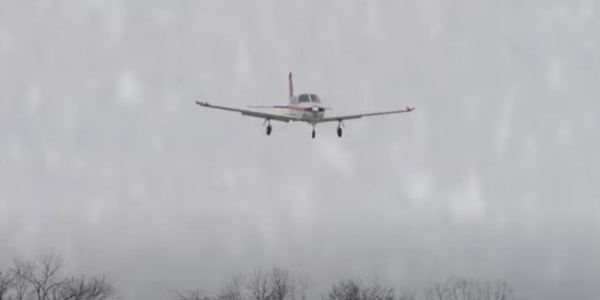Reviewing a crash caused by icy conditions, tips on encountering mid-flight icing

Photo from FAA, tips on safely flying in winter weather
On October 31, 1994, an ATR 72 encountered dangerous icing conditions in the sky that resulted in a crash that killed all 64 passengers and four crew on board. The plane crash was caused by in-flight icing in a plane that should not have been allowed to operate in such conditions. After the crash of AE Flight 4184, the FAA made changes for flying during icy conditions and the families of the victims began a journey to change national legislation and how the victims and families of aviation disasters are treated.
Weather can be an unavoidable hazard in the sky due to the unpredictability of mother nature and the inability to counteract the extreme impact it can have on an aircraft. Winter weather in particular can pose a safety risk, from snow-covered runways to icing conditions in the air.
The investigation found the ATR 72 flight manual did not adequately prepare the crew for how to operate under such conditions. The FAA was also found to have failed to ensure that the aircraft icing certification requirements were met. The FAA had inadequate oversight for the ATR 72 and 42’s airworthiness in icing conditions. Following the crash, the FAA issued 18 ADs and significant revisions to pilot operating procedures in icing conditions. The flight led to change, not only for aircraft flying in icing conditions but for those who are most affected by air disasters, the victims and families.
After the Flight 4184 crash, the families of the victims scrutinized the way the investigation and treatment of the remains and personal effects of their loved ones were handled. There were 68 caskets for the victims, but most were buried in 17 caskets of unidentified remains and one family received misidentified remains. The 17 caskets were interred at night without consent from the families and most of the identifiable personal effects were destroyed instead of returned. Even after the clean-up was completed, families would return to the site and see human remains, belongings and plane parts.

Legislation changes after the crash
Flight 4184 families came together to advocate for the victims, writing to government officials and connecting with families of victims of other plane crashes. Families of the AE flight and multiple other crashes joined together to form two not-for-profit organizations, the National Air Disaster Alliance for advocacy effort and the National Air Disaster Foundation which supported the families with survivor support and education efforts.
On October 9, 1996 President Clinton signed HR 3539, the FAA Reauthorization Act of 1996 into law and included the Aviation Disaster Family Assistance Act of 1996. This law led to the NTSB creating the Transportation Disaster Assistance (TDA) Division within the agency, which aims to meet the needs of family members and survivors after a transportation accident.
On the day of the crash, American Eagle Flight 4184 took off from Indianapolis International Airport (IND) inbound to Chicago’s O’Hare International Airport (ORD). Jason Kroot noted that because of weather-related delays, O’Hare’s air traffic control placed AE 4184 in a holding pattern while they awaited additional clearance. While established in the holding pattern, AE 4184 encountered freezing rain and ice build-up on the wings. A warning sound went off, indicating an overspeed warning due to the extended flaps was heard in the cockpit. The ice ultimately resulted in an uncontrolled roll and the imminent crash of American Eagle Flight 4184 into a soybean field near Roselawn, Indiana. All sixty-four passengers or four crew members died in the crash.
According to the NTSB report, the temperatures were about 3 degrees Celsius with moisture evident in the area where flight 4184 was holding. The 1800 analysis of the 700 millibar data (recorded about 10,000 feet MSL) indicated an area of low pressure, with the center located in northern Illinois, and a southwesterly flow over the accident area. Temperatures were near minus 4 degrees Celsius with moisture evident in northern Indiana. At 500 millibars (about 18,000 feet), the center of the low-pressure area was located in northeastern Iowa and had a southwesterly flow over the area of the accident. Temperatures were near minus 18 degrees C with moisture evident in the area. A moderate stationary front was also present and had extended eastward from the center of the low-pressure area. In addition, precipitation in the form of rain showers associated with this system was occurring to the north (ahead) of the stationary front and west (behind) of the cold front. The accident site was north of the stationary front, where surface temperatures of plus 7 degrees Celsius were being reported. There were also roughly 13 PIREPs (pilot reports) reported that day in reference to icing conditions.

Reported time, temperature and altitude from the NTSB report
Flying into known icing conditions is illegal unless an aircraft has been explicitly certified to. However, encountering unexpected and unforeseen in-flight icing conditions is a risk that all pilots face. In-flight structural icing can exist any time there is visible moisture and the outside air temperature is within the freezing range.
To avoid the risk of encountering structural icing, pilots should practice thorough weather briefing analysis. Paying close attention to the outside air temperature reports can reveal a lot about the current weather conditions because icing typically forms between 0 and 20 degrees Celsius. AIRMET Zulus are a valuable resource as well because they report moderate icing and freezing levels to pilots. PIREPs are valuable as well because they can contain observations of in-flight icing conditions. These resources provide pilots with all of the weather information they need to conduct safe flights and make the right decisions.

In-flight icing example from FAA
If a pilot were to encounter unexpected mid-flight icing, they should take the following steps to ensure a safe flight. When encountering mid-flight icing, turn on the pitot heat to preserve the integrity of the airspeed indicator, inform air traffic control of the situation, get the aircraft out of the current location and into ice-free airspace (if on an IFR flight plan, request a lower altitude, a 180-degree turn, or declare an emergency if necessary), keep the engine running and be wary of possible carb icing by pulling on the carb heat and adjusting the mixture (a roughness in the engine performance will be an early indication), and land immediately.
Winter weather is a risk for even the most experienced pilot. Pilots should be aware of weather conditions that could impact their flight plans and stay grounded when possible. When encountering icy weather, know how to respond properly and safely land during unexpected mid-flight conditions.

Recent Comments